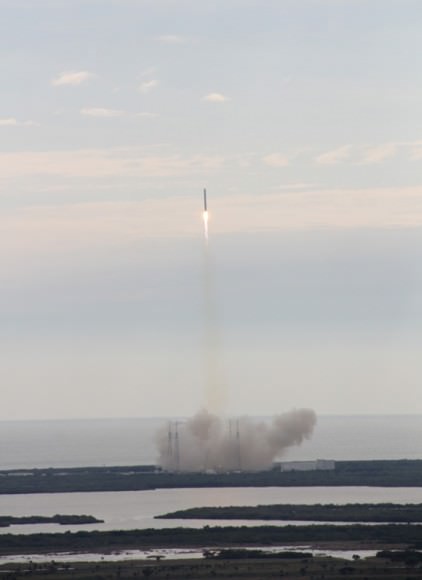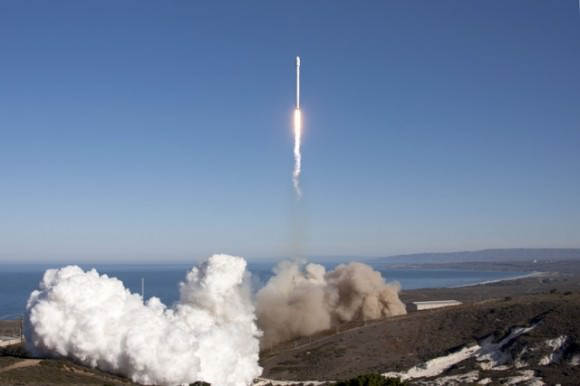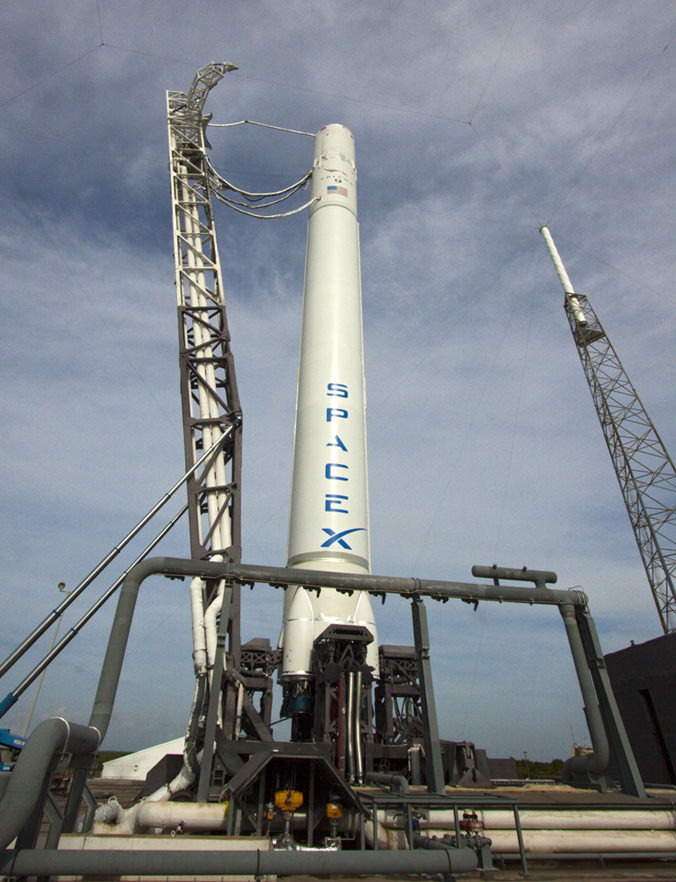Falcon 9 during processing at Cape Canaveral Pad 40 ahead of launch scheduled for Nov. 25, 2013. Credit: SpaceX
See live SpaceX webcast link below[/caption]
CAPE CANAVERAL, FL – The maiden flight of the Next Generation commercial SpaceX Falcon 9 rocket from the firms Cape Canaveral launch facility is set to soar to space on Monday afternoon, Nov. 25 on a ground breaking mission that will be most difficult ever.
The upgraded Falcon 9 booster is slated to haul the commercial SES-8 telecommunications satellite for the satellite provider SES for SpaceX’s first ever payload delivery to a Geostationary Transfer Orbit (GTO).
Liftoff is scheduled for 5:37 p.m. EST from SpaceX’s Space Launch Complex 40 pad at Cape Canaveral Air Force Station.
Pad 40 is the same location as all prior SpaceX launches from the Florida Space Coast.
SpaceX CEO Elon Musk tweeted that this launch of the Falcon 9 will be the “toughest mission to date.”

This mighty new version of the Falcon 9 dubbed v1.1 is powered by a cluster of nine of SpaceX’s new Merlin 1D engines that are about 50% more powerful compared to the standard Merlin 1C engines. Therefore it can boost a much heavier cargo load to the ISS, low Earth orbit and beyond.
The next generation Falcon 9 is a monster. It’s much taller than a standard Falcon 9 – some 22 stories tall vs. 13 stories.
In anticipation of Monday’s planned liftoff, SpaceX engineers successful completed a wet dress rehearsal and engine hotfire test this past Thursday.
Spectators can view the launch from local public areas, beaches and roads – just as with any other liftoff.
The launch window extends just over an hour until 6:43 p.m. EST.
Weather outlook is 80% favorable at this time but deteriorates in case of a 1 day delay to Tuesday.

SpaceX is planning a live webcast of the launch with commentary from SpaceX corporate headquarters in Hawthorne, CA.
The broadcast will begin at approximately 5:00 p.m. EDT and include detailed discussions about the Falcon 9 rocket, launch and flight sequences as well as about the SES- 8 satellite.
The webcast can be viewed at; www.spacex.com/webcast
The first launch of this next generation Falcon 9 v 1.1 rocket occurred on Sept 29, 2013 on a demonstration test flight from a SpaceX pad at Vandenberg AFB carrying a Canadian weather satellite to an elliptical earth orbit.

SES-8 is a hybrid Ku- and Ka-band spacecraft that will provide communications coverage for the South Asia and Asia Pacific regions.
It was built by Orbital Sciences spacecraft, weighs 3,138 kg (6,918 lbs) and will be lofted to a 295 x 80,000 km geosynchronous transfer orbit inclined 20.75 degrees.
Stay tuned here for continuing SpaceX & MAVEN news and Ken’s SpaceX launch reports from on site at Cape Canaveral & the Kennedy Space Center press site.
…………….
Learn more about SpaceX, LADEE, MAVEN, MOM, Mars rovers, Orion and more at Ken’s upcoming presentations
Nov 22-25: “SpaceX launch, MAVEN Mars Launch and Curiosity Explores Mars, Orion and NASA’s Future”, Kennedy Space Center Quality Inn, Titusville, FL, 8 PM
Dec 11: “Curiosity, MAVEN and the Search for Life on Mars”, “LADEE & Antares ISS Launches from Virginia”, Rittenhouse Astronomical Society, Franklin Institute, Phila, PA, 8 PM


Er – your picture of ‘Falcon 9 during processing’ prior to launch shows engine fairings similar to old version Falcon 9. The new version 1.1 has engines laid out in a circular (not square) formation obviating the need for engine fairings. Could this possibly be a stock photo of the discontinued Falcon 9?
Is this flight going to include any tests for booster soft landing?
I’d guess no because every ounce of fuel will be needed to boost the payload way up to synchronous orbit. The previous flight, the first with the new Merlin engines was a booster soft landing developmental test flight. Space-X sold it cheaply so that they could double use the launch as a subsidized test flight.
No. The last soft landing test was a partial failure, so modifications need to be made to the rocket before the next test. The next test is currently scheduled for 3 months from now at the end of Feb 2014.
The current rumour is that SpaceX is trying to get permission to do a soft landing on land test (with landing legs and everything), but we don’t know for sure yet.
Sure do hope the upper stage re-ignition gremlins are sorted g652003.
Not long untill we all find out.
Go SpaceX.
No. The next test will be during the CRS-3 resupply of the ISS in February. The next two satellite launches were contracted before SpaceX had the ability to try reusability tests. They are also further out at synchronous orbit and trying to save fuel for a test would put the satellite in jeopardy.
Folks:
Oops, wrong Falcon in the top image. That’s an original Falcon. You can tell by the fairing at the bottom of the rocket (and how short it is).
tinker
Can we view the launch in person? We are from So Cal but are currently at WDW.
Good luck…I guess. Stay safe anyway.
Go Space-X! Go Falcon 9 V 1.1!
I’m curious, if it’s much bigger, has more powerful engines, and has other redesigns (e.g. the aforementioned engine fairings), why is it still called the Falcon 9. Old Falcon 9 and New Falcon 9 is kind of clumsy. Couldn’t they call it the Falcon 10 or something? Is the name just so cool they can’t mess with it?
it has nine engines.
9 engines… vs. the now retired falcon 1 and falcon 5 that had 1 and 5 engines.. There is already a plan for a Falcon X which has only 1 big ass engine…
Then at least call it the 9B or something. It’s confusing to have two completely different models with the same name.
Is the 80,000 km figure for the transfer orbit apoapsis correct? Geosynchronous orbit is at 42,164 km, so burning up that high doesn’t make sense at first glance.